
All Saints Church is the Anglican parish church of Patcham, an ancient Sussex village which is now part of the English city of Brighton and Hove. A place of worship has existed on the hilltop site for about 1,000 years, but the present building has Norman internal features and a 13th-century exterior. Several rounds of restoration in the Victorian era included some structural additions. A wide range of monuments and wall paintings survive inside, including one commemorating Richard Shelley—owner of nearby Patcham Place and one of the most important noblemen in the early history of Brighton. The church, which is Grade II* listed, continues to serve as the Anglican place of worship for residents of Patcham, which 20th-century residential development has transformed from a vast rural parish into a large outer suburb of Brighton.

St Margaret's Church is an Anglican church in the Ifield neighbourhood of Crawley, a town and borough in West Sussex, England. It is the ancient parish church of the village of Ifield; the medieval settlement was expanded to form one of the New Town of Crawley's 13 neighbourhoods, and the church's modern parish now serves several other neighbourhoods as well.
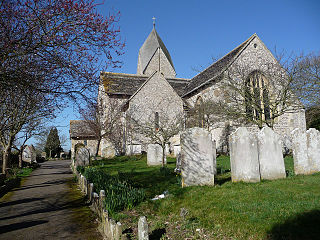
The Church of St Mary the Blessed Virgin, also known as St Mary the Virgin Church and St Mary's Church, is the Church of England parish church of Sompting in the Adur district of West Sussex. It stands on a rural lane north of the urban area that now surrounds the village, and retains much 11th- and 12th-century structure. Its most important architectural feature is the Saxon tower topped by a Rhenish helm, a four-sided pyramid-style gabled cap that is uncommon in England. English Heritage lists the church at Grade I for its architecture and history.
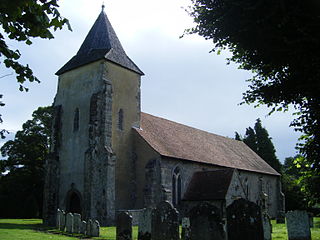
St. George's Church is an Anglican church in Trotton, a village in the district of Chichester, one of seven local government districts in the English county of West Sussex. Most of the structure was built in the early 14th century. However, some parts date to around 1230, and there is evidence suggesting an earlier church on the same site. In 1904, a largely intact and unusually detailed painting was found on the west wall depicting the Last Judgment as described in Matthew 25:31–46.
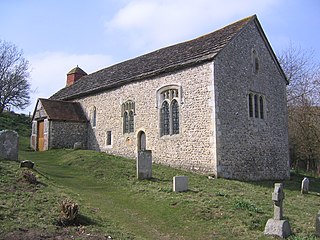
Coombes Church is a Church of England parish church in the rural hamlet of Coombes in the Adur District of West Sussex, England. It has served the rural parish, northwest of Shoreham-by-Sea and next to the River Adur, since the 11th century. Despite several re-buildings, some structural elements remain from that period. An important series of wall paintings, dating from the 12th to the 18th century, were uncovered in 1949. English Heritage has listed the church at Grade I for its architectural and historical importance.
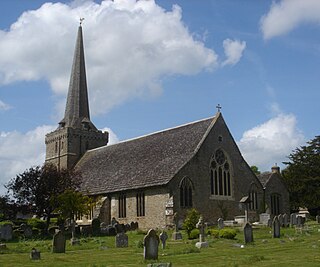
Holy Trinity Church is an Anglican church in the village of Cuckfield in the district of Mid Sussex; one of seven local government districts in the English county of West Sussex. It was founded in the 11th century and was in the possession of Lewes Priory by 1090. The present structure dates from the mid-13th century but was extended in the 14th century and heavily altered and restored during the Victorian period, with much interior work by Charles Eamer Kempe and stained glass by both Kempe and the Clayton and Bell firm. The church's spire was replaced in 1981 following a fire. Former chapels of ease in outlying hamlets have closed, and the church now serves a large rural area in the centre of Sussex. It is protected as a Grade I listed building.

St Mary's Church is an Anglican church in the village of Slaugham in Mid Sussex, one of seven local government districts in the English county of West Sussex. The 12th- and 13th-century church, restored in the Victorian era, serves a large rural area of the Sussex Weald, covering three villages as well as the ancient settlement of Slaugham. It also controlled the church in the market town of Crawley—now one of the area's largest towns—for the first few centuries of its existence. A locally important family built a private chapel in the church in the 17th century, and a series of memorials to deceased family members are considered to be excellent examples of their type. English Heritage has listed the building at Grade II* for its architectural and historical importance.
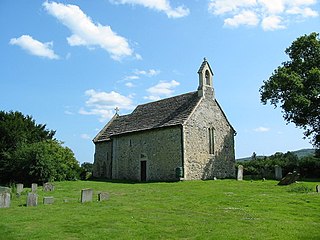
All Saints Church is an Anglican church in the hamlet of Buncton in the district of Horsham, one of seven local government districts in the English county of West Sussex. Built in the 11th or 12th century as a small chapel of ease to a nearby parish church, and hardly changed or restored since, the stone chapel stands behind a "delightful ... wooded ravine" beneath the South Downs and has been called "a real piece of hidden Sussex". The chancel arch, between the nave and chancel which made up the simple two-room building, had a bizarre 12th-century carving of a person of indeterminate sex exposing their genitalia—until 2004, when an unknown vandal destroyed it with a chisel. The church is still used for Christian worship, and English Heritage has listed it at Grade I for its architectural and historical importance. The church is also known as Buncton Chapel.

St John the Baptist's Church is the Church of England parish church of the village of Clayton in Mid Sussex District, one of seven local government districts in the English county of West Sussex. The small and simple Anglo-Saxon building is distinguished by its "remarkable" and extensive set of wall paintings, dating from the early 12th century and rediscovered more than 700 years later. Much of the structural work of the church is 11th-century and has had little alteration. The church, which stands in the middle of a large churchyard and serves the small village of Clayton at the foot of the South Downs, is part of a joint parish with the neighbouring village of Keymer—an arrangement which has existed informally for centuries and which was legally recognised in the 20th century. English Heritage has listed the church at Grade I for its architectural and historical importance.
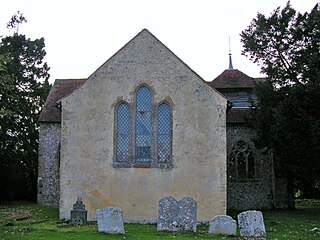
North Stoke Church, rededicated in 2007 to St Mary the Virgin after its medieval dedication was unexpectedly rediscovered, is a former Church of England parish church in the riverside hamlet of North Stoke in the Horsham District of West Sussex. The partly 11th-century cruciform building, set in an almost deserted village in a loop of the River Arun, is mostly unrestored and stands on an ancient earthwork which has pre-Christian origins. The building has architectural features and internal fittings spanning hundreds of years, including some very old stained glass and wall paintings, although there are few memorials compared with other Sussex churches of a similar age. The church, "movingly eloquent of centuries of remote Sussex agricultural life", is no longer used for worship: it was declared redundant in 1992, after which it was entrusted to the Churches Conservation Trust. English Heritage lists the church at Grade I for its architectural and historical importance.

St Mary Magdalene's Church is the former Anglican parish church of the hamlet of Tortington in the district of Arun, one of seven local government districts in the English county of West Sussex. Founded in the 12th century to serve a priory and villagers in the riverside location, it has experienced little change despite a 19th-century restoration. Its ancient chancel arch and doorway have remarkable carvings with "grotesque, boggle-eyed monsters", rare beakhead figures and chevron ornamentation. Standing in a picturesque setting behind a farm, the flint and Caen stone building was used for worship until 1978, when it was declared redundant. It is now cared for by the Churches Conservation Trust, and English Heritage has listed it at Grade II for its architectural and historical importance. The church is dedicated to Jesus's companion Mary Magdalene.

St Wilfrid's Chapel, also known as St Wilfrid's Church and originally as St Peter's Church, is a former Anglican church at Church Norton, a rural location near the village of Selsey in West Sussex, England. In its original, larger form, the church served as Selsey's parish church from the 13th century until the mid 1860s; when half of it was dismantled, moved to the centre of the village and rebuilt along with modern additions. Only the chancel of the old church survived in its harbourside location of "sequestered leafiness", resembling a cemetery chapel in the middle of its graveyard. It was rededicated to St Wilfrid—7th-century founder of a now vanished cathedral at Selsey—and served as a chapel of ease until the Diocese of Chichester declared it redundant in 1990. Since then it has been in the care of the Churches Conservation Trust charity. The tiny chapel, which may occupy the site of an ancient monastery built by St Wilfrid, is protected as a Grade I Listed building.

St Botolph's Church is the Church of England parish church of Hardham, West Sussex. It is in Horsham District and is a Grade I listed building. It contains the earliest nearly complete series of wall paintings in England. Among forty individual subjects is the earliest known representation of St George in England. Dating from the 12th century, they were hidden from view until uncovered in 1866 and now "provide a rare and memorable impression of a medieval painted interior". The simple two-cell stone building, with its original medieval whitewashed exterior, has seen little alteration and also has an ancient bell.

Greatham Church is the Anglican parish church of the hamlet of Greatham in the district of Horsham, one of seven local government districts in the English county of West Sussex. The tiny single-room building has been described variously as "delightful" and "one of the most appealing churches in Sussex". The unrestored 12th-century stone church serves a rural area near the River Arun and sits apart from the hamlet next to the ancient manor house. The church is a Grade I Listed building.

The Grade I listed Saxon church of St Botolph's at Botolphs, West Sussex, England, is situated in the valley of the River Adur and is now part of the Church of England parish of Beeding and Bramber with Botolphs. An earlier dedication to St Peter de Vetere Ponte is now lost, like the bridge over the Adur from which it took this ancient name. The church serves the mostly depopulated hamlet of Botolphs in the Horsham district of West Sussex. The church has fragments of medieval wall paintings. Architectural historian Ian Nairn comments that the Jacobean pulpit is "notable in a county which is poor in 17th century fittings".

St Mary Magdalene's Church is an Anglican church in the village of Bolney in Mid Sussex, one of seven local government districts in the English county of West Sussex. The parish church, which is dedicated to Jesus' companion Mary Magdalene, serves a large rural parish centred on a village straddling the ancient London–Brighton road and apparently dates from about 1100, and an older origin has been suggested. Many structural additions have been made over the centuries—including a tower built solely using the labour of villagers—and at the entrance to the churchyard is a "magnificent" 20th-century lychgate made of local materials including Sussex Marble. The church is protected as a Grade I Listed building.

St Margaret's Church is an Anglican church in the village of West Hoathly in Mid Sussex, one of seven local government districts in the English county of West Sussex.

St George's Church is an Anglican church in the village of Eastergate in West Sussex, England. It is the ancient parish church of Eastergate, although since 1992 it has been administered as part of a joint ecclesiastical parish with the churches in neighbouring Barnham and Aldingbourne. As part of this group, the building is still in regular use for worship on Sundays and weekdays. Eastergate village school has links with the church, and pupils regularly attend services.
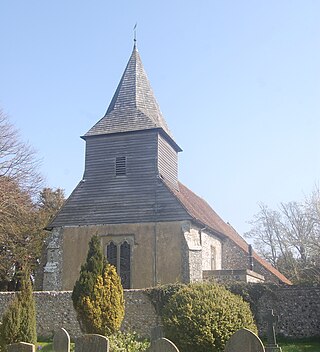
St Mary and St Peter's Church is in the village of Wilmington, East Sussex, England. It is an active Anglican parish church on the deanery of Lewes and Seaford, the archdeaconry of Lewes and Hastings, and the diocese of Chichester. Founded in the late 11th century to serve villagers in a rural area at the foot of the South Downs, it also functioned as a priory church for the monks from the adjacent Wilmington Priory, to which it was physically connected. The building has "benefited from sympathetic restoration" over the centuries—including a series of works by prominent architects Paley and Austin in the Victorian era, and internal renovation after a fire in the early 21st century. The church is recorded in the National Heritage List for England as a designated Grade I listed building.

St Peter's Church is a Church of England parish church in the large village of Henfield, West Sussex. Placed on the site of an 8th-century Saxon church also dedicated to St Peter, it was built in the 13th, 14th and 15th centuries, but was heavily restored and partially rebuilt in the 19th century. English Heritage has listed it at Grade II* for its architectural and historical importance. Services for the parish continue and also cover the parishes of St Giles', Shermanbury and St. Peter's, Woodmancote, which form its united benefice.

































